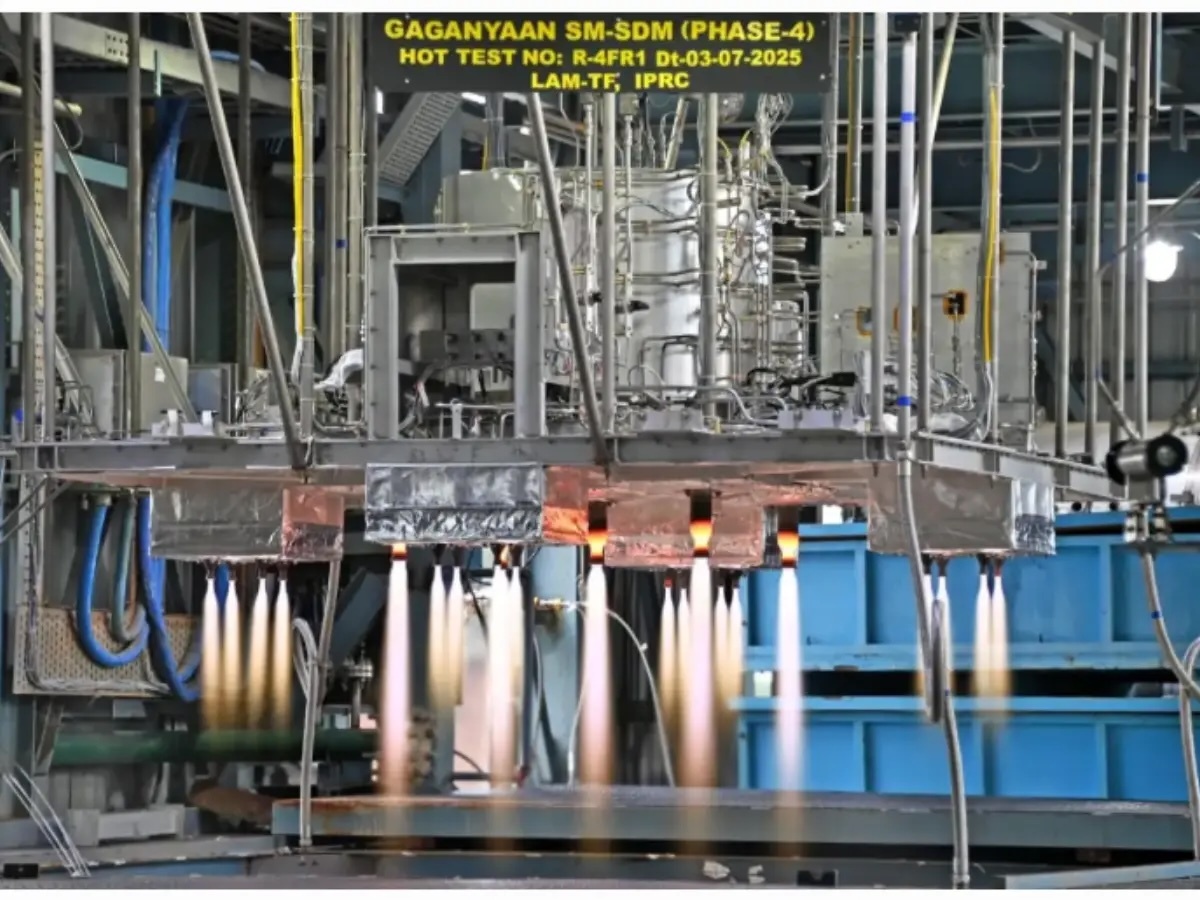9.07.2025

Indian space agency ISRO announced the recent successful completion of two engine firing tests of the system that will propel the Indian-made Gaganyaan astronaut-carrying capsule in space. Formally known as the Gaganyaan Service Module Propulsion System (SMPS), it was tested at the ISRO Propulsion Complex (IPRC), Mahendragiri, Tamil Nadu.
Two short duration test firings were conducted for 30seconds and 100seconds to validate the test article configuration. The overall performance of the propulsion system during these hot tests was normal, as per pre-test predictions. During the 100seconds test, simultaneous operation of all Reaction Control System thrusters(small engines) in different modes (steady state; pulsed) along with all Liquid Apogee Motors(primary engines) was also successfully demonstrated.
ISRO’s Liquid Propulsion System Centre (LPSC) is leading the technology development activities for the Gaganyaan SMPS. SMPS is a critical system of Gaganyaan Orbital Module and is required during orbital manoeuvring as well as specific abort scenarios. Simply put, the thrusters will help the Gaganyaan capsule manoeuvre in space, change its orientation.
The SMPS comprises five Liquid Apogee Motor (LAM) engines (each generating 440Newtons of thrust) and 16 Reaction Control System (RCS) thrusters (each generating 100Newtons of thrust). In order to simulate the propulsion system conditions closer to flight, the SMPS test article for these hot tests incorporated improvements based on experience gained from earlier hot tests. With the confidence gained through these hot tests, ISRO will conduct a full duration hot test shortly.
Liquid apogee motor did not fire in NVS-02
In January this year, ISRO launched the NVS-02 satellite, which is the second among five satellites in the NVS-series. This series is meant to provide Position, Navigation, and Timing services over the Indian subcontinent region(Indian mainland and 1500kms away from Indian borders). While the GSLV Mk2 rocket placed the NVS-02 in its intended initial orbit, the satellite's primary engine(liquid apogee motor) firings did not happen as planned, which left the satellite stuck in its initial orbit.
The engine that failed in the NVS-02 mission is the 440Newton thruster which also finds place in the Gaganyaan SMPS. Almost all engines that propel ISRO's satellites are bipropellant engines, which means a fuel and oxidizer must come into contact for the engine firing to happen.
ISRO uses Monomethyl Hydrazine(MMH) as fuel and Mixed Oxides of Nitrogen(MON) as the oxidizer. This is known as a hypergolic combination, which means that the chemical reaction(burning) takes place as soon as the fuel and oxidizer come into contact with each other. Regarding the technical issue in the NVS-02 satellite, ISRO had said, "orbit raising operations towards positioning the satellite to the designated orbital slot could not be carried out as the valves for admitting the oxidizer to fire the thrusters for orbit raising did not open."
Such setbacks would mean that ISRO has to further enhance its quality control, testing, given the crucial role played by the liquid apogee motors. While ISRO has not identified the exact cause that led to the NVS-02 failure, ISRO will be implementing some hardware and software changes in subsequent NVS satellites after thorough testing and analysis. Further, additional checkpoints, review mechanisms, verification methodologies are incorporated, ISRO revealed in response to an RTI(Right to Information) query.
Preparations for Gaganyaan unmanned mission G-1
This SMPS test is one among thousands of system and sub-system level testing that ISRO would be carrying out ahead of the Gaganyaan G1 mission, which is the maiden uncrewed flight of the Gaganyaan series. Instead of an astronaut, the uncrewed Gaganyaan craft would carry a humanoid robot Vyommitra to space and return to earth for a splashdown landing. ISRO intends to perform at least three flawless unmanned Gaganyaan missions, before putting astronauts on the Gaganyaan flight.
Quelle: WION
